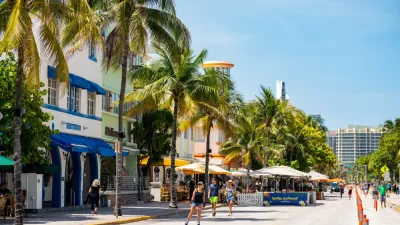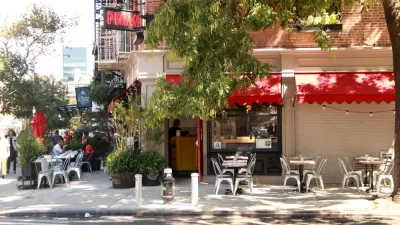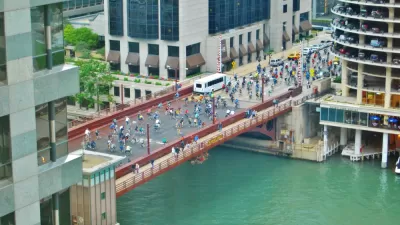The successes and failures of past pedestrian malls can inform the future of pandemic-induced "open streets" programs.

The COVID-19 pandemic, writes Stephan Schmidt, emphasized the importance of public, outdoor space as cities around the world opened previously car-centric streets to pedestrians and reimagined street space as more than a way to move cars from place to place. "Alternatively referred to as slow, open, shared or active streets, many of these pandemic-inspired closures were successful, and several cities opted to continue these street changes over the course of the summer."
Now, "as summer ends and cities continue to reopen, local officials will need to decide whether to revert to the status quo or make the often-popular pedestrianized corridors permanent."
Describing the history of American pedestrian malls and their rise and fall during the 1960s through 1990s, Stephan Schmidt draws comparisons to today's pandemic streets, taking lessons from the successes and failures of the past to inform our current car-free projects. Cities, Schmidt writes, can "utilize design interventions to create more desirable pedestrian environments" and support car-free areas.
Based on his research, Schmidt describes four elements of successful pedestrian malls. These include "creating a sense of enclosure and requiring the use of ground-floor windows to increase transparency," protection from weather and varied seating options, visual appeal created through landscaping, and programmed activities. He also recommends that pedestrian malls seek connections with adjacent properties to reduce a feeling of isolation and increase pedestrian traffic.
"Many downtowns and central business districts now have more full-time residents than they did in decades past, a density boost that bodes well for this new wave of shared streets. Officials must weigh many factors as they bring their urban centers back to 'normal,' but they should remember that, for many, normal means experiencing the city via a car-free public space."
FULL STORY: Lessons From the Rise and Fall of the Pedestrian Mall

Trump Administration Could Effectively End Housing Voucher Program
Federal officials are eyeing major cuts to the Section 8 program that helps millions of low-income households pay rent.

Planetizen Federal Action Tracker
A weekly monitor of how Trump’s orders and actions are impacting planners and planning in America.

Ken Jennings Launches Transit Web Series
The Jeopardy champ wants you to ride public transit.

Milwaukee Road to Get Complete Streets Upgrades
The city will reduce vehicle lanes and build a protected multi-use trail including bioswales and other water retention features on its ‘secret highway.’

Tackling Soil Contamination With Nature-Based Solutions
Los Angeles County residents and experts are turning to nature-based methods like bioremediation to address long-standing and fire-exacerbated soil contamination without resorting to costly and disruptive removal.

Rebuilding Smarter: How LA County Is Guiding Fire-Ravaged Communities Toward Resilience
Los Angeles County is leading a coordinated effort to help fire-impacted communities rebuild with resilience by providing recovery resources, promoting fire-wise design, and aligning reconstruction with broader sustainability and climate goals.
Urban Design for Planners 1: Software Tools
This six-course series explores essential urban design concepts using open source software and equips planners with the tools they need to participate fully in the urban design process.
Planning for Universal Design
Learn the tools for implementing Universal Design in planning regulations.
Ada County Highway District
Clanton & Associates, Inc.
Jessamine County Fiscal Court
Institute for Housing and Urban Development Studies (IHS)
City of Grandview
Harvard GSD Executive Education
Toledo-Lucas County Plan Commissions
Salt Lake City
NYU Wagner Graduate School of Public Service





























